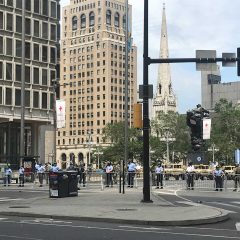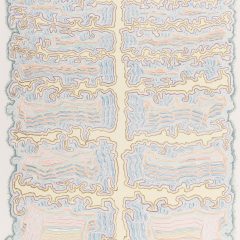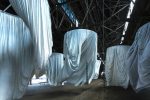
Vera Lutter, 30th Street Station, Philadelphia IV: April 20, 2006, 50 3/8 x 146 inches, commissioned by the Print Center, ©Vera Lutter, 2006
Thinking big, The Print Center invited internationally known artists Vera Lutter, Abelardo Morrell and Ann Hamilton to photograph Philadelphia with cameras obscura. Two of the artists, Lutter and Morrell, made enormous, thoroughly contemporary images of great visual, psychic and physical impact. Hamilton made a number of more modest images that reflected a sense of Philadelphia’s own aesthetic traditions.
The two big ones blew me away.
Lutter, who was born in Germany and trained there as a sculptor but now lives and works in New York, clearly had absorbed the aesthetics of the Bechers back in Germany. Her camera obscura negative images of infrastructure captures all the details the naked eye in motion edits out. The size of the piece puts the viewer in a physical relationship to this bustling, bristling world of box cars, rails, wires and other mysterious structures. A relatively close pole (perhaps a telephone pole) becomes a scale for measuring the space, as well as a stand-in for the viewer. The picture, an ode to the old technology that railroads represent, rises to metaphor for Philadelphia as a pass through between New York and Washington, as well as a metaphor for the speed at which we all travel.
To catch that speed took time, 105 minutes, so anything in motion disappeared in the process, which included a specially built 4- x 12-foot camera obscura parked in an Amtrak garage. I’ve seen some large Lutter pieces before. The work is instantly recognizable and memorable, but I can’t remember the venue.

Abelardo Morell, Camera Obscura Image of the Philadelphia Museum of Art East Entrance on Gallery #171 with a de Chrico Painting, 72 x 92 1/4 inches, commissioned by the Print Center, ©Abelardo Morrell, 2006
Abelardo Morell captures a very different view of Philadelphia in his equally enormous photo. He presents a visual puzzle in his first use of color with the camera obscura. The image is an iconic shot of the Philadelphia Museum of Art superimposed over a gallery wall hung with a de Chirico. I won’t tell you how it’s done, because that will take away some of the puzzle, and I love a puzzle, so I presume you do too.
The glow of light and color captured by the long exposure is luscious, and the piazza in the painting talks to the museum facade. The little ladder propped against the wall works in much the way that the telephone pole in Lutter’s photo works. It grounds the piece in the world of humans.
This is the third museum Morell has photographed. The others are the Ufizzi Gallery in Florence, and the Whitney in New York City. He who was born in Havana, Cuba, and received his MFA from Yale.

Ann Hamilton, Print and Picture Collection, Central Library, Free Library of Philadelphia, reading . 1, June 2006 21 1/2 x 9 inches, commissioned by The Print Center, ©Ann Hamilton
Ann Hamilton, known for her ambitious installations about time and erasure, created a more modest product, a series of photographs of Philadelphia landmarks, including include Bloomsday readers and listeners on the 19th Century street where the Rosenbach Museum and Library reside; readers at the Free Library Central’s main reading room; services at Old St. George’s Church and Gloria Dei (Old Swedes’) Church; and unison readings at Carpenters’ Hall.
These had the smell of Philadelphia dust and limits about them. They remained true to Hamilton’s visions of time and the transitory nature of words and humans, but they seemed less ambitious and bold than her installations. They also seemed familiar. The visions of ghostly people passing through a church space reminded me of Eileen Neff’s photo of the sanctuary in Rodeph Shalom (see post), which was in an exhibit there that was part of the ICA-organized Big Nothing city-wide extravaganza.
Of Hamilton’s work, I especially liked her Pepper Hall, Central Library, Free Library of Philadelphia, reading . 5, June 2006, the first-floor piece where the pages of a book become a disembodied chevron of light. Hamilton, by the way, used Photoshop to make changes in her images. The others used straight photographic processes. I found this especially amusing, given the almost antique quality that Hamilton’s work exuded.
This small exhibit, curated by Jacqueline Van Rhyn, received significant support from the Philadelphia Exhibitions Initiatives. Small enough to fit in the little Print Center, the show manages to merge the global and the local, and to merge the most traditional methods with contemporary results.
I missed Hamilton’s talk, one of a series related to the exhibit, but here’s the schedule for the other talks.









